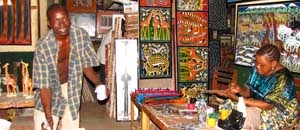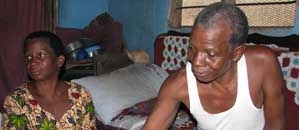TINGATINGA AND THE MOZAMBIQUE MYTH
Berit Sahlström, a Swedish professor in African Studies claims in her article from 1996 that Edward Saidi Tingatinga was born in Mozambique. The Tingatinga Arts Co-operative (TACS) and family of E.S Tingatinga disagree with the Mozambique link. In fact Berit Sahlström starts her article with Mozambique. Once there was a man called Eduardo S. Tingatinga. He was born in Mozambique, but during the 1960s he established an art form that became associated with his new homeland, Tanzania. (see http://art-bin.com/art/atingae.html)
When Tingatinga´s children Martina and Daudi and TACS decided to write to Berit Sahlström she refused to change the birthplace of E.S.Tingatinga to Tanzania where he was really born. She told that Tanzania could have a political interest to claim the Tingatinga art to be its national identity though it comes from Mozambique.

Daudi (left) and Martina (right) should notice that their father came from Tanzania and not Mozambique
Unfortunately the article which is otherwise very informative, is copied all over the world and it has been spread among galleries, museums, literature, catalogues etc. Many people think that Tinga Tinga art has really originated in Mozambique. Unfortunately the disinformation has also been copied by international media because Tiger Aspect Production plans to launch globally a series of 52 films called Tinga Tinga Tales. Tinga Tinga was already referred as Mozambican on the website where Tiger Aspect advertises, see http://www.worldscreen.com/articles/display/22591) The reason for the popularity of the article is that the article has a very good Google ranking. Although the article was written in 1996, Berit Sahlström refuses to add the date to the article so most readers think that the article is a new research.
The disinformation about E.S.Tingatinga´s birthplace spreads fast and the consequences for members of TACS are painful. For example a certain website is depicting a photo of the painters at the Tingatinga Cooperative. The photo is accompanied by text: “Tingatinga was born in Mozambique but the art is associated with his new homeland Tanzania”. The paradox is that the same painters who are on the photo protested to write such statement. (look here: http://www.pbase.com/glipper/image/72536057)
Berit Sahlström maintains that she cited her student Mia Terent, who wrote a research paper on Tinga Tinga for a short 4 weeks course on Islamic and African Art. When the manager of TACS contacted Mia Terent, she admitted that she never visited Tanzania while she made the research about Tinga Tinga art. She saw two Tinga Tinga paintings brought to Sweden by her parents and she liked them so she decided to do a research. She interviewed another Swedish, Barbro Johansson who lived in Tanzania.
And it was this Swedish woman who told to Mia Terent about that E.S.Tingatinga was born in Mozambique. Mia further concludes in her mail to TACS that she (Barbro Johansson) was in good health despite high age. She did not know where Barbro got the information but because she is unfortunately dead we can´t ask her. Then Mia Terent suggested that somebody else could write a new research article. It could be even the children of E.S.Tingatinga who could start to research about their father.

Do the European or American art researchers have right to write that Galusi´s older brother has lived in Mozambique without even visiting Tanzania and meeting the family members? Do they have right to publish the disinformation even after the protest of the family?
It was absurd when the children of E.S.Tingatinga heard that somebody in Sweden who has never met them could spread this disinformation. Mia Terent and Berit Sahlström don´t want to accept the results of other researchers either. The book written by the artists themselves is also ignored. Berit Sahlström will not correct the article, because it was written 12 years ago, she maintains. Unfortunately, the article has no date.
Paradoxically Berit Sahlström uses photos of the old paintings made by a Danish researcher Jesper Kirknaes. The owner of the photos claims rightfully that E.S.Tingatinga was born in Tanzania. http://74.125.113.132/search?q=cache:c5S7Y0MlRnAJ:www.afrikagrupperna.se/cgi-bin/afrika.cgi%3Fd%3Ds%26w%3D1715+kirknaes+tingatinga&cd=3&hl=sv&ct=clnk&gl=se. Even this has not convinced Berit Sahlström to correct the information about Tingatinga´s birthplace.
Interestingly Berit Sahlström is suggesting that Tanzania could have a political interest in owning Tingatinga art. She writes (approximate translation form her letter): ”It is known that the modern Makonde sculptures were renamed to Ujama in Tanzania. In this way Makonde art became politically and nationally a part of Tanzanian heritage even if there was no difference between the Tanzanian sculptures and those sold in Maputo. It is important the art is used in national interest but it is also important that the art historians do not change the history to advantage of other nation.
Berit Sahlström´s last words were: “I will not change anything (Mozambique) in an article which was written a decennium ago” Berit Sahlström left her academic position in 2006 and returned to her work as a practicing artist. She is married with professor of African History Tegeste Natashe living half of the year in Mozambique. (see:
STATEMENT OF CHILDREN OF E.S.TINGATINGA AND TINGATINGA ARTS CO-OPERATIVE SOCIETY
Tinga Tinga is purely Tanzanian art and there is no link to Mozambique regarding the family of E.S.Tingatinga. Both parents and grandparents of E.S.Tingatinga were born in Tanzania. Daudi and Martina Tingatinga, the children of E.S.Tingatinga consider themselves to be Tanzanians with no roots in Mozambique. It is unfortunate that the disinformation is spread on the Tingatinga exhibitions, literature and other media. The only source of this disinformation is the article published online by the Swedish professor of African Studies Berit Sahlström. The information about Mozambique contradicts all other research. The information is not of academic but personal nature.
The text of this webpage is available for modification and reuse under the terms of the Creative Commons Attribution-Sharealike 3.0 Unported License and the GNU Free Documentation License (unversioned, with no invariant sections, front-cover texts, or back-cover texts).
SOME ARTICLES COPYING THE DISINFORMATION ABOUT MOZAMBIQUE
2. http://www.africanart.com/tingatingapaintings.aspx
4. http://www.maridadiartz.com/paintings/id35.html
6. http://www.nameloksafaris.com/en/tingatinga.php
7. http://www.magic-safaris.com/country/detail.php?cid=3
Author: Daniel Augusta





